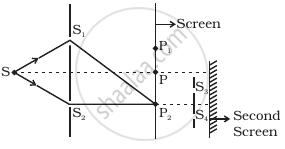Advertisements
Advertisements
प्रश्न
State Huygens’s principle. Show, with the help of a suitable diagram, how this principle is used to obtain the diffraction pattern by a single slit.
Draw a plot of intensity distribution and explain clearly why the secondary maxima becomes weaker with increasing order (n) of the secondary maxima.
उत्तर
Huygen’s principle states that
-
Each point on a wave front behaves as a source of secondary wavelets
-
The secondary wavelets travel with the speed of light in that medium
-
The position of new wave front at a later time can be found out by drawing a common tangent to all these secondary wavelets
Intensity distribution of single slit distribution

For the first secondary maxima (n = 1), only one-third of the slit contributes to its intensity.
Secondly, for n = 2, only one-fifth of the slit contributes to the intensity.
Therefore, with increasing n, the intensity decreases.
APPEARS IN
संबंधित प्रश्न
Using Huygens's construction of secondary wavelets explain how a diffraction pattern is obtained on a screen due to a narrow slit on which a monochromatic beam of light is incident normally.
State Huygen's principle.
The refractive indices of water and diamond are `4/3` and 2.42 respectively. Find the speed of light in water and diamond. (c = 3x108 m/s)
Using Huygens’ principle, verify the laws of reflection at a plane surface.
What is the geometrical shape of the wavefront for:
- Light diverging from a point source?
- The pattern of wavefront of the light from a distant star intercepted by earth?
Wavefront means
Figure shows a standard two slit arrangement with slits S1, S2, P1, P2 are the two minima points on either side of P (Figure). At P2 on the screen, there is a hole and behind P2 is a second 2-slit arrangement with slits S3, S4 and a second screen behind them.

For light diverging from a point source ______.
- the wavefront is spherical.
- the intensity decreases in proportion to the distance squared.
- the wavefront is parabolic.
- the intensity at the wavefront does not depend on the distance.
Is Huygen’s principle valid for longitudinal sound waves?
How is a wavefront different from a ray?
